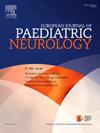杜氏肌营养不良症的晚期诊断仍然是现实吗?
IF 2.3
3区 医学
Q3 CLINICAL NEUROLOGY
引用次数: 0
摘要
杜氏肌营养不良症(DMD)是一种由DMD基因致病性变异引起的进行性x连锁隐性神经肌肉疾病,表现为儿童早期进行性肌肉无力。肌肉无力的最初症状通常出现在三岁左右,然而,这种疾病的其他症状,如肌肉肥大、运动技能差、社交、语言和运动迟缓,可以更早发现。据报道,在许多国家,DMD的诊断过程出现了严重延误,诊断通常需要5年左右。进行了一项合作历史队列研究,以确定巴西五个神经肌肉中心诊断DMD的年龄,涵盖2019年1月至2024年3月诊断的病例。除了来自中心的数据外,诊断年龄的数据还来自巴西国家罕见病网络(RARAS)。最终的分析队列包括173名DMD个体。患者根据临床怀疑诊断为可能的DMD的平均年龄为5.7(±2.7)岁,通过基因检测/肌肉活检确诊为6.9(±4.0)岁,中位数分别为6.0和6.8岁。父母发现症状的平均年龄为3.4(±1.9)岁,中位数为3.0岁。父母最常观察到的初始症状包括经常跌倒(35.5%)、步态异常(31.4%)、爬楼梯困难(17.2%)、发育迟缓(13.6%)和从地板上站起来困难(8.9%)。同时出现神经认知疾病与疑似诊断时的中位年龄延迟1.12年(p = 0.008)和确诊时的中位年龄延迟1.0年(p = 0.022)相关。这些结果表明,尽管近几十年来巴西DMD的诊断年龄有所改善,但诊断时间仍然晚于理想水平,低于高收入国家的水平。本文章由计算机程序翻译,如有差异,请以英文原文为准。
Is late diagnosis of Duchenne muscular dystrophy still a reality?
Duchenne muscular dystrophy (DMD) is a progressive X-linked recessive neuromuscular disorder caused by pathogenic variants in the DMD gene manifesting in early childhood with progressive muscle weakness. First symptoms of muscle weakness usually appear around age of three, however, other signs of the disease like muscle hypertrophy, poor motor skills and social, language and motor delay can be detected earlier. Significant delays in the diagnostic process for DMD have been reported in many countries, with the diagnosis generally being made around five years. A collaborative historical cohort study was conducted to identify the age at diagnosis of DMD in five neuromuscular centers in Brazil, covering cases diagnosed between January 2019 and March 2024. In addition to data from the centers, data on age at diagnosis were obtained from The Brazilian National Network for Rare Diseases (RARAS). The final analytic cohort included 173 DMD individuals. The mean age at which patients were diagnosed with probable DMD based on clinical suspicion was 5.7 (±2.7) years, with diagnostic confirmation by genetic testing/muscle biopsy at 6.9 (±4.0) years, with medians of 6.0 and 6.8 years, respectively. The mean age at which parents noticed symptoms was 3.4 (±1.9) years with a median of 3.0 years. The most frequently observed initial symptoms by parents included frequent falls (35.5 %), gait abnormalities (31.4 %), difficulties in stair climbing (17.2 %), developmental delay (13.6 %), and difficulties in rising from the floor (8.9 %). The presence of co-occurring neurocognitive conditions was associated with a delay of 1.12 years (p = 0.008) in the median age at suspected diagnosis and 1.0 years in the median age at diagnosis confirmation (p = 0,022). These results suggest that while there have been improvements in the age of diagnosis of DMD in Brazil in recent decades, diagnosis still occurs later than ideal and then what has been achieved in high-income countries.
求助全文
通过发布文献求助,成功后即可免费获取论文全文。
去求助
来源期刊
CiteScore
6.30
自引率
3.20%
发文量
115
审稿时长
81 days
期刊介绍:
The European Journal of Paediatric Neurology is the Official Journal of the European Paediatric Neurology Society, successor to the long-established European Federation of Child Neurology Societies.
Under the guidance of a prestigious International editorial board, this multi-disciplinary journal publishes exciting clinical and experimental research in this rapidly expanding field. High quality papers written by leading experts encompass all the major diseases including epilepsy, movement disorders, neuromuscular disorders, neurodegenerative disorders and intellectual disability.
Other exciting highlights include articles on brain imaging and neonatal neurology, and the publication of regularly updated tables relating to the main groups of disorders.

 求助内容:
求助内容: 应助结果提醒方式:
应助结果提醒方式:


